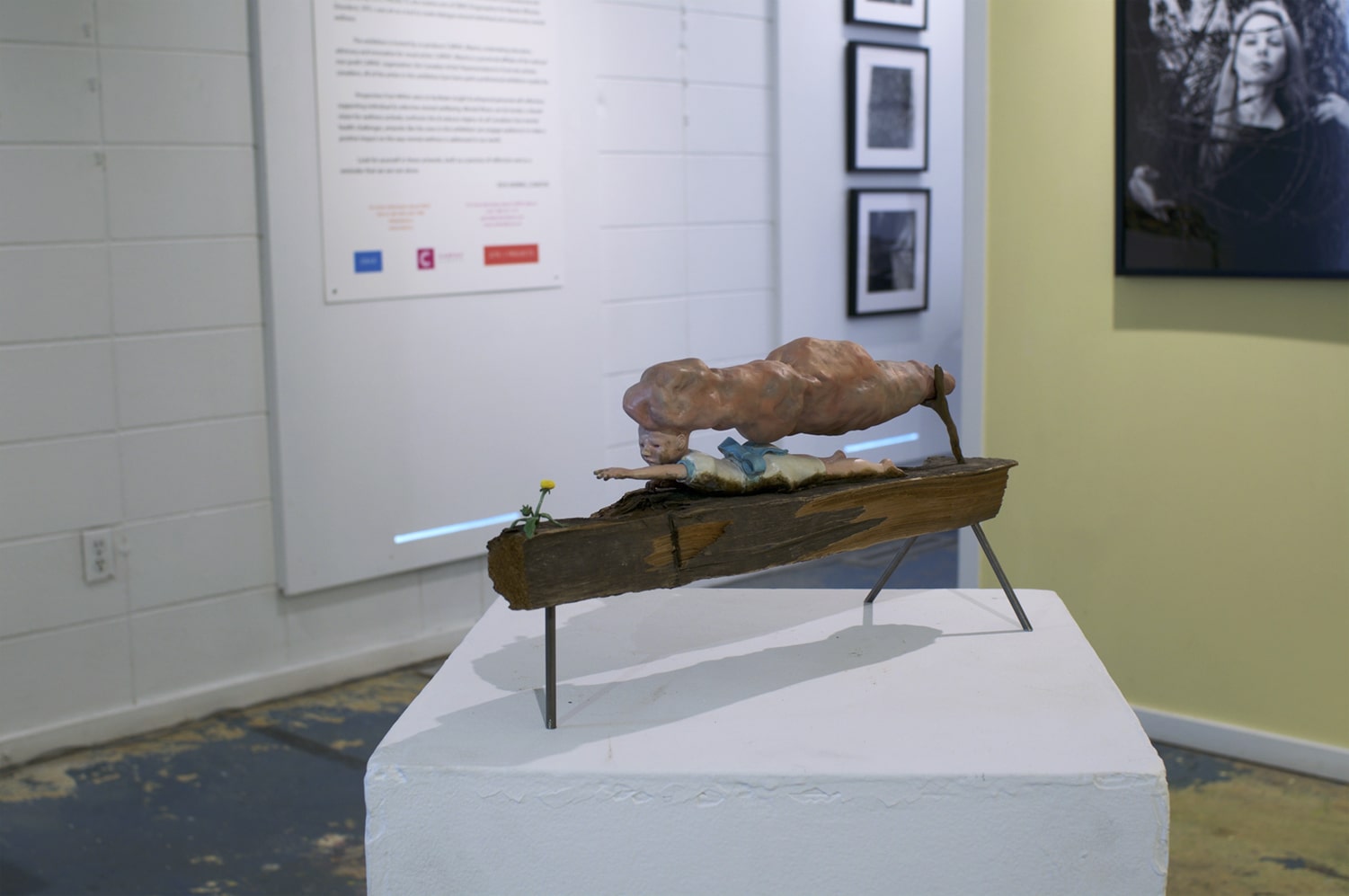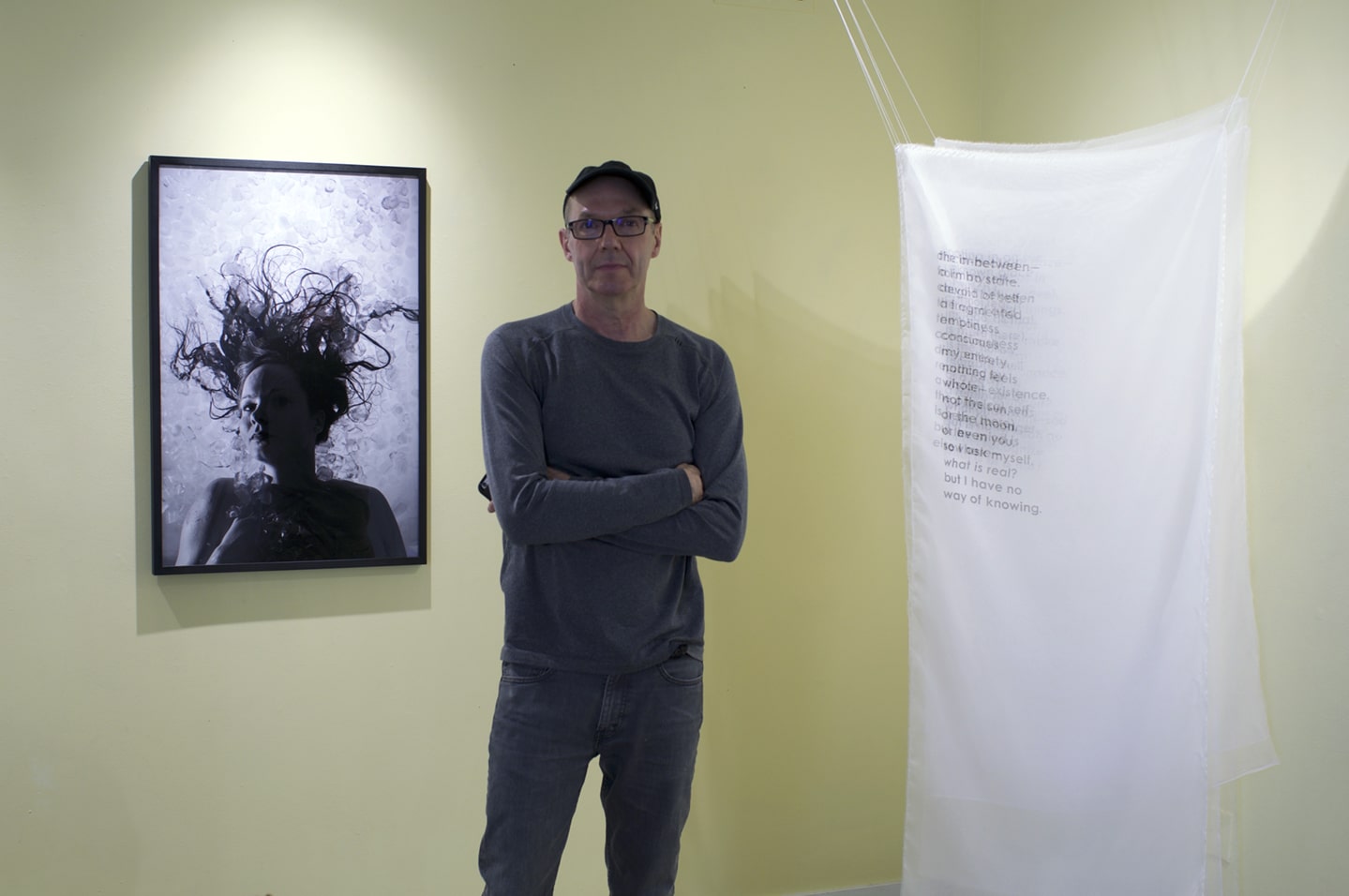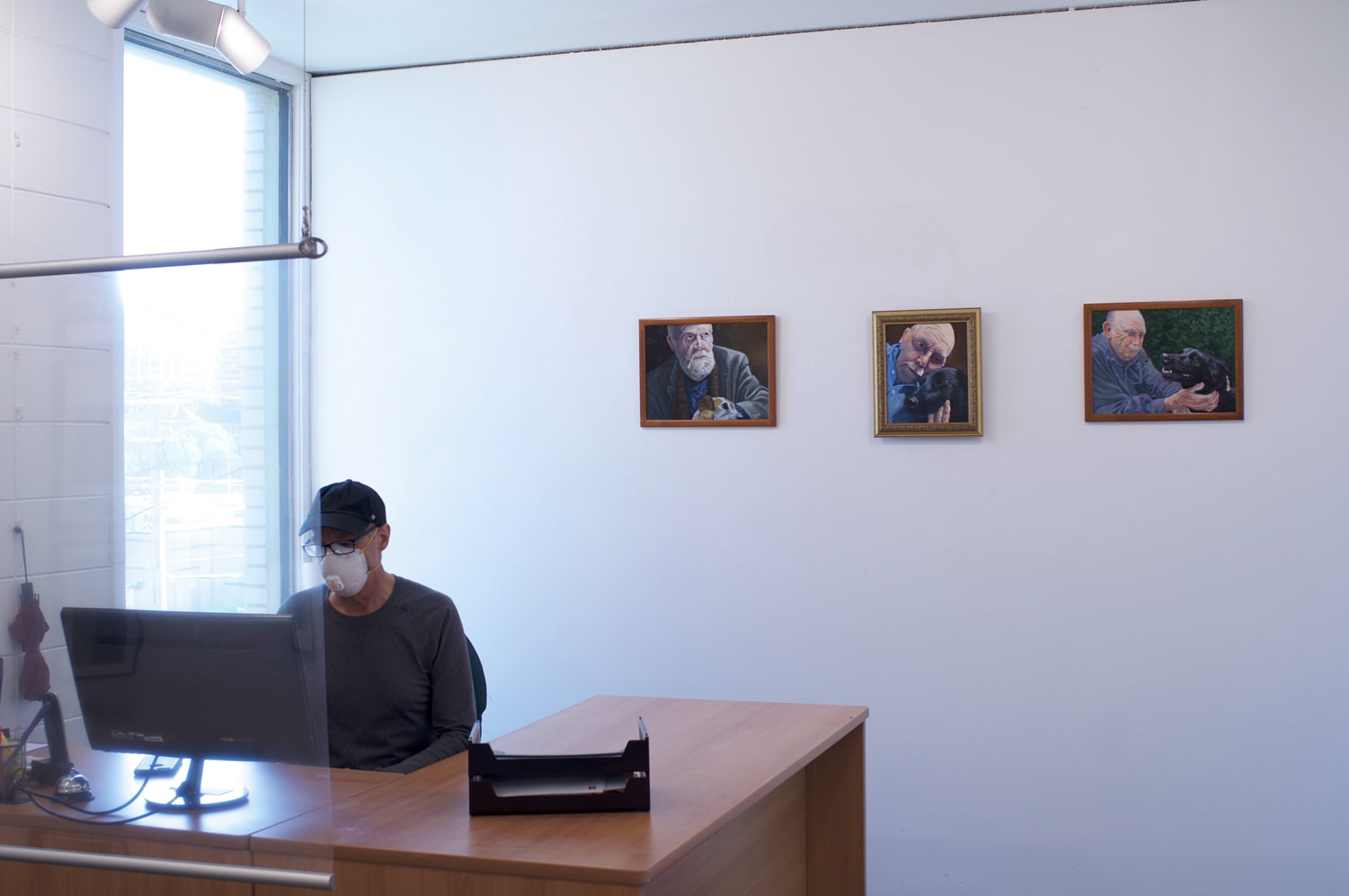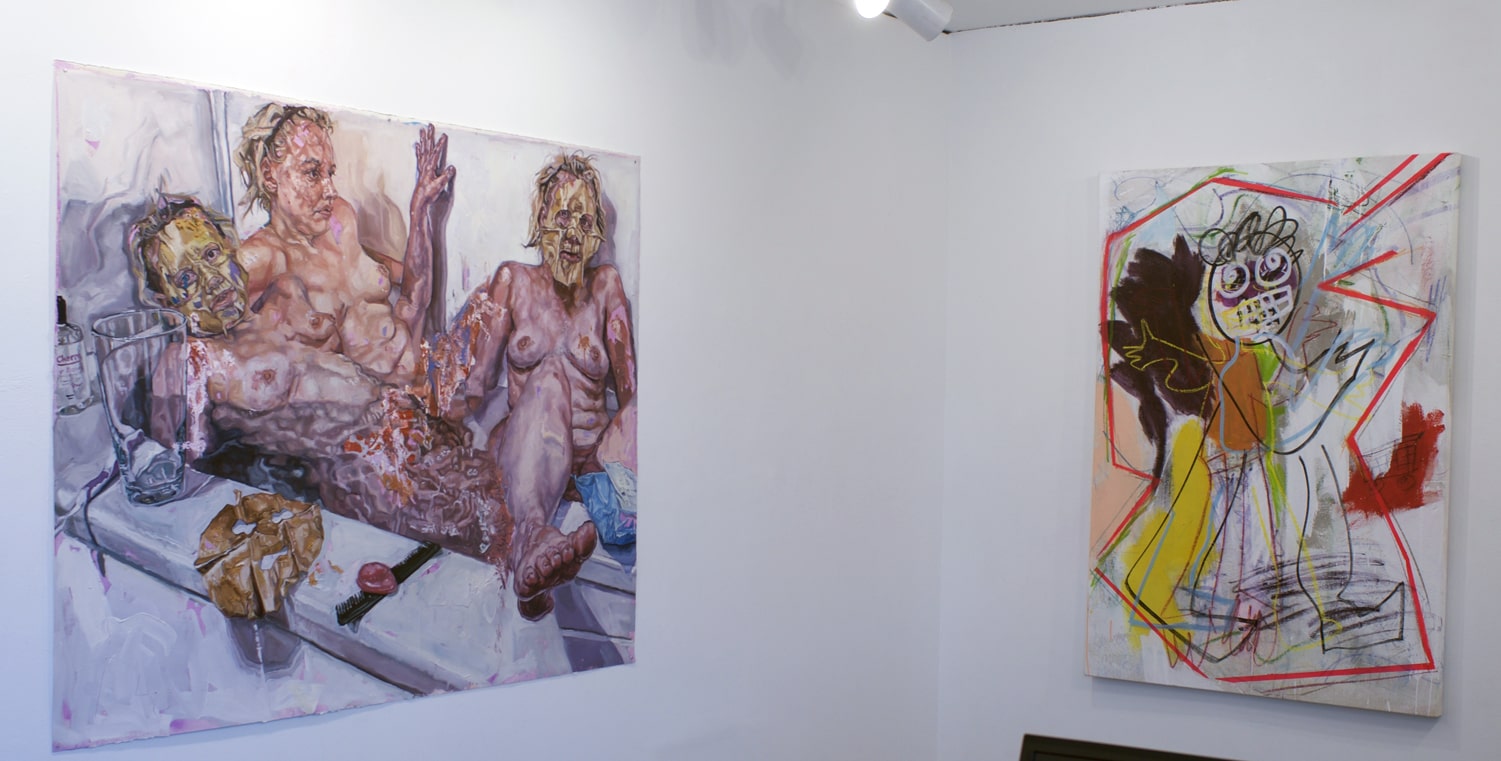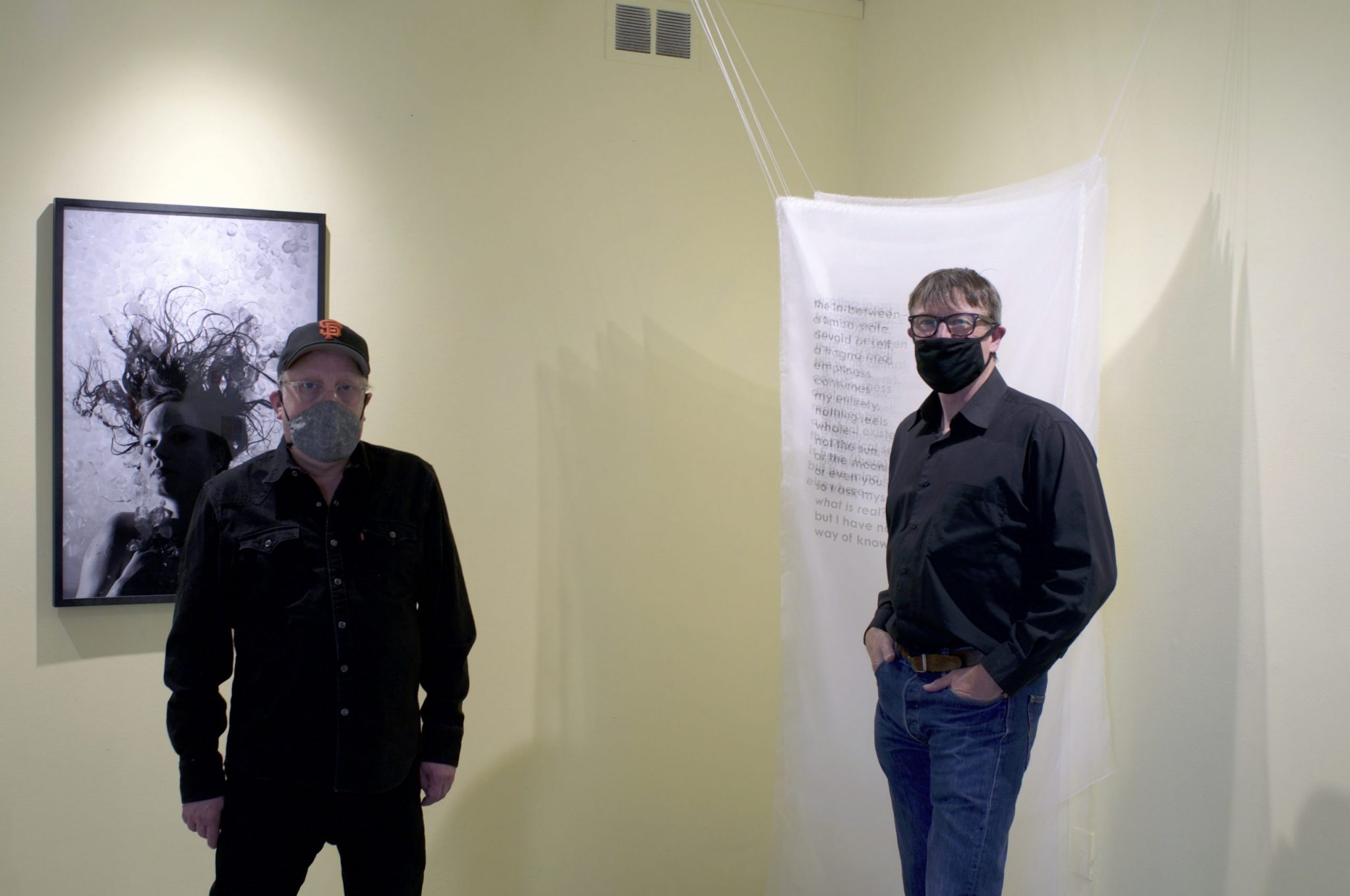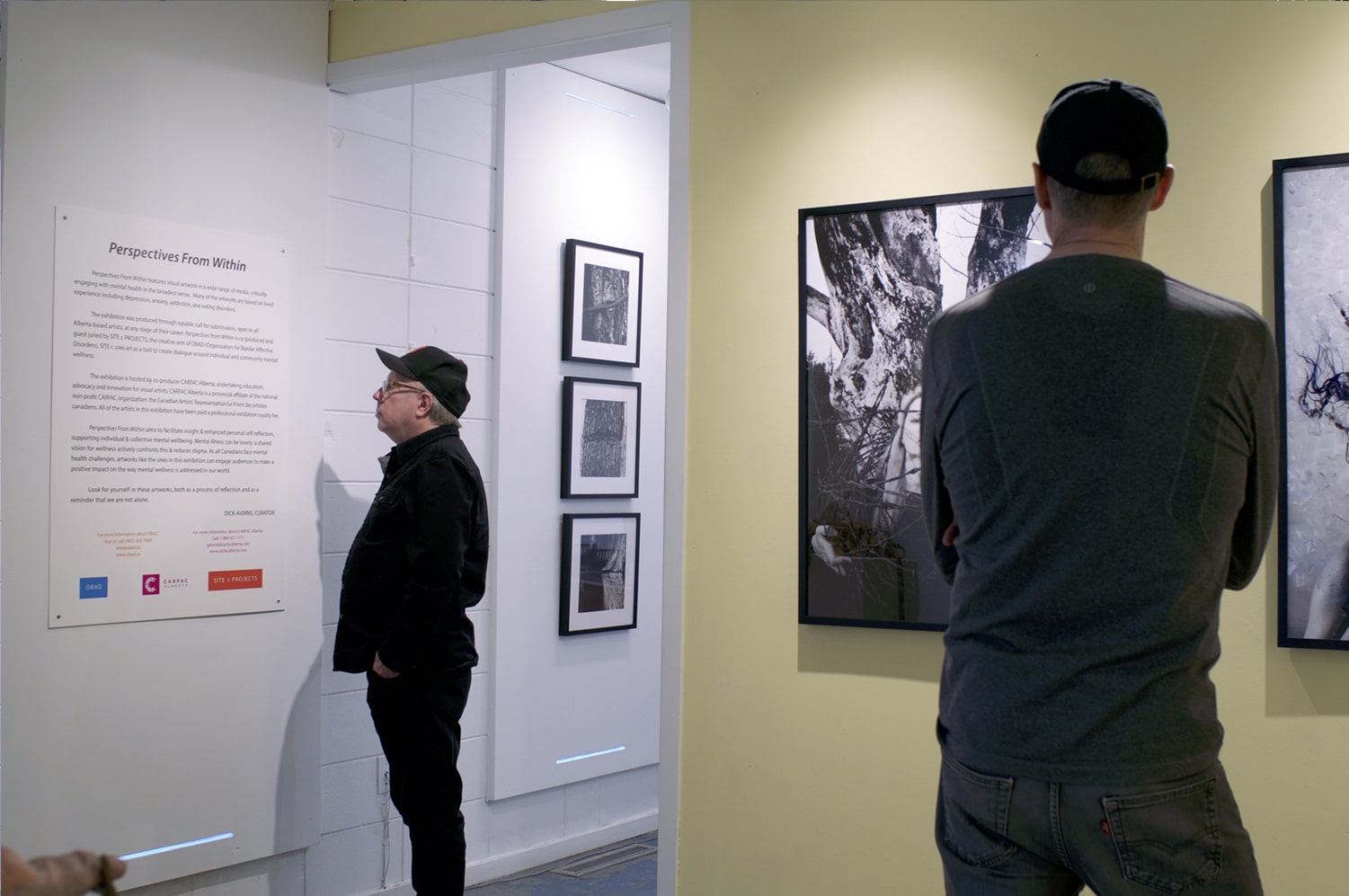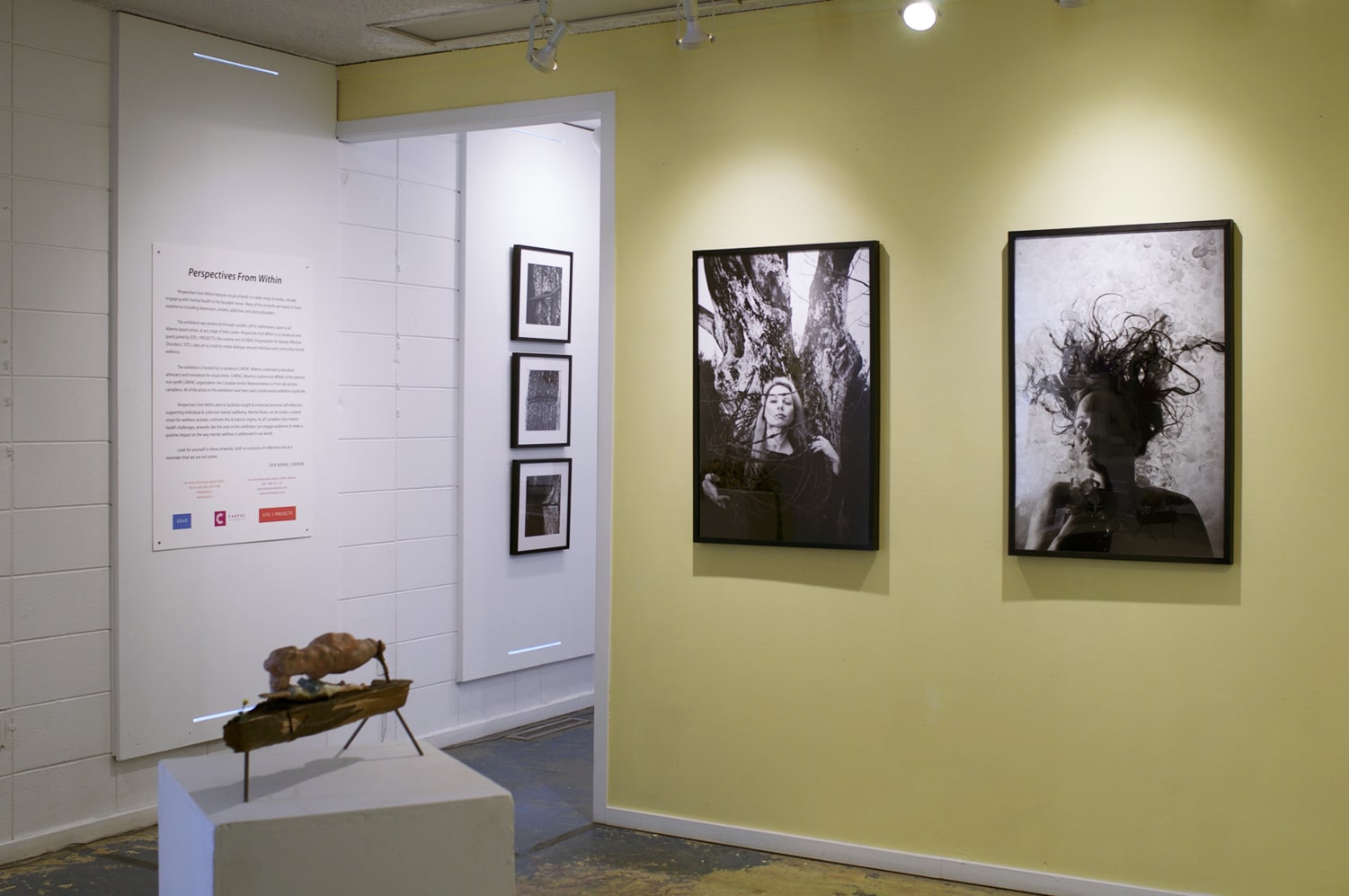Perspectives From Within features visual artwork in a wide range of media, critically engaging with mental health in the broadest sense. Many of the artworks are based on lived experience including depression, anxiety, addiction, and eating disorders.
The exhibition was produced through a public call for submissions, open to all Alberta-based artists, at any stage of their career. Perspectives from Within is co-produced and guest juried by SITE c PROJECTS, the creative arm of OBAD (Organization for Bipolar Affective Disorders). SITE c uses art as a tool to create dialogue around individual and community mental wellness.
The exhibition is hosted by co-producer CARFAC Alberta, undertaking education, advocacy and innovation for visual artists. CARFAC Alberta is a provincial affiliate of the national non-prot CARFAC organization: the Canadian Artists’ Representation/Le Front des artistes canadiens. All of the artists in this exhibition have been paid a professional exhibition royalty fee.
Perspectives From Within aims to facilitate insight & enhanced personal self-reflection, supporting individual & collective mental wellbeing. Mental illness can be lonely: a shared vision for wellness actively confronts this & reduces stigma. As all Canadians face mental health challenges, artworks like the ones in this exhibition can engage audiences to make a positive impact on the way mental wellness is addressed in our world.
Look for yourself in these artworks, both as a process of reflection and as a reminder that we are not alone.
DICK AVERNS, CURATOR
Installation Gallery
Krista Acheson
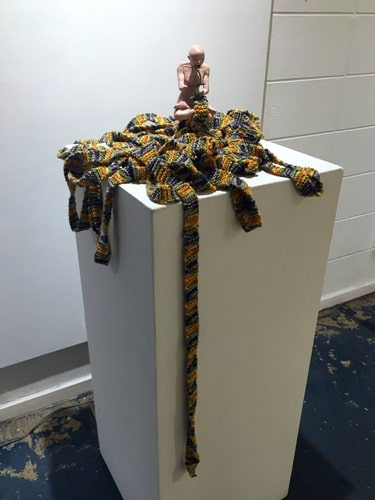
Making the best of it (2015) mixed media, $250
Included in this show: 3 prototype sculptures from my 2016 exhibition, Inside Out.
Someday, I hope to secure funding in order to recreate them on a larger scale. I feel a big gallery installation would create a more immersive experience and serve to drive home the point of how heavy and oppressive the experience of mental illness is, in a way that these small sculptures may fail to convey.
The sculptures are meant to be a visual expansion of the diagnostic criteria list, outlined in the DSM-5, regarding Bipolar Disorder.
Kind of a this is how this feels– expressed in 3D form, from the perspective of someone who has experienced it.
I felt it might offer a different dimension to something that can be as subjective as a symptoms list; words can sometimes be too open to interpretation – like how you can Google symptoms of the flu and end up fearing you have cancer.
I wanted to try to put experiences into a visual language that, potentially, only someone who had first hand experience with/knowledge of, would be able to recognize as familiar— even if they didn’t “get” or like the sculpture.
At the 2016 show it actually proved highly effective. Invariably, people seemed to be drawn to only specific sculptures and needed to ask about them; always following my response with their personal experience related to it.
Notably, one person whose mother was bipolar and, from his account, had a fairly tragic childhood as a result.. said the presence of the sculptures “felt” eerily familiar and were upsetting to him. He preferred to talk to me at the front of the gallery, with the sculptures out of his eyeline.
What affected me the most was when a lady contacted me on Facebook to tell me that, after seeing a photo of the sculpture ‘Constance’ and the write up in the newspaper, she went to the gallery to see it in person because it had helped her understand, on some level, what her son was living with before taking his own life.
For any artist reading that last paragraph, I hope it can stay with you as a reminder that sometimes our art can serve a higher purpose than we can even imagine.
Artist Bio
As a visual artist, I create distinct bodies of work and exhibit them under 3 aliases: Krista Acheson, Gerri Harden and M.N.V. The sculptures in this exhibition are from a series’ of 10 prototypes that I created under the alias Gerri Harden. The directive of any work I create under this particular alias is that I am trying to impact people on an emotional level with the hopes of inspiring empathy towards the topic being explored in my exhibition.
For questions about the meaning behind these pieces, upcoming shows or other works that might be for sale…
Email: GH@kristaacheson.com
Instagram: @gerriharden
Facebook: GerriHardenArt
If you want to know about/follow along with all the work I do, ( all art aliases and music projects) feel free to friend request or follow me on Facebook at my personal account: www.facebook.com/KristaAcheson
It’s an amalgamation page of all my creative efforts and I update it the most often.
Alexis Marie Chute
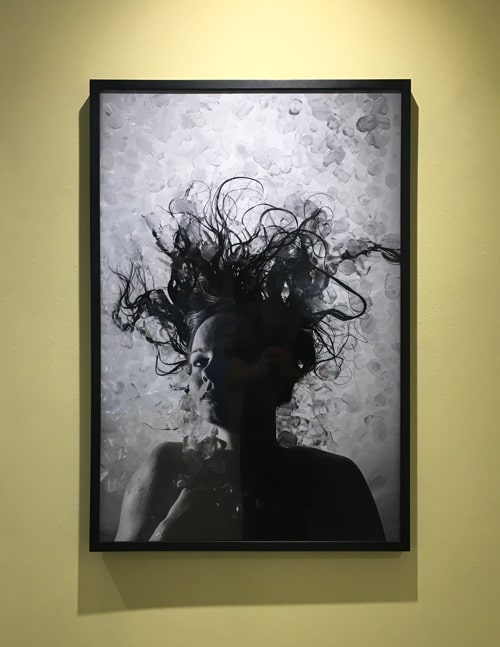
Healing 10 (Kamea) $700 From The Quiet Rebuild Series (2014)
Artist Statement
For decades I have been told I must choose: “Be a painter or a photographer or a writer.” Fortunately, I have not listened. I am a visual and literary artist, an author, documentary filmmaker, curator, and inspirational public speaker and teacher. I thrive in pushing the boundaries of traditional approaches to making art and living our best lives. Across my many creative roles, the overarching connection in my work is that of storytelling.
Narrative is crucial in my art; the idea of connecting the dots and finding the threads that bind everything together. I believe that even when there is no answer to a question, the search is transformative. In sharing stories through my work, I have been honored to connect with others, a process which invites them to be vulnerable themselves. I often invite individuals and groups into the art-making process through collaboration. Creativity is the language which facilitates all this, expressing the sometimes inexpressible qualities of the human experience.
Themes in my work include hope, transformation, connection, nature, healing, and resiliency. My approach begins with a concept to which I let the materials that move me become central. I paint, create fine art photographs, build wood sculpture and wall based sculptural art, write prose and poetry – and frequently combine these 2D and 3D materials, and literary art, in distinctive ways. Filmmaking also brings together my diverse experience and education in unique and culturally relevant ways. artist website
Zana Wensel
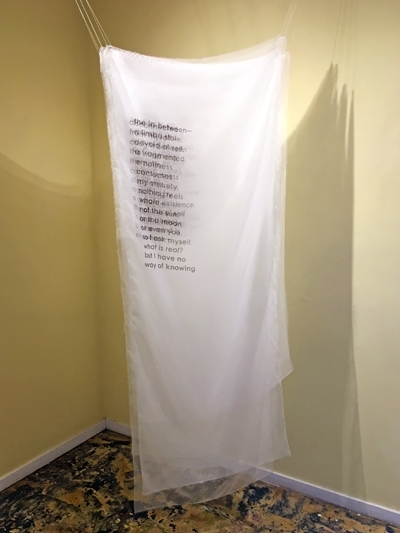
The In-Between Screen-printed text on organza, NFS
“The best way to define dissociation is through the experience of it. In its mildest forms, it manifests as a kind of spaciness. At the other end of the spectrum, it can develop into a so-called multiple personality syndrome. Because dissociation is a breakdown in the continuity of a person’s felt sense, it almost always includes distortions of time and perception. A mild variety of this symptom is responsible for the experience many people have when driving home from the corner store; suddenly, they find themselves arriving home with no memory of how they got there…” (Levine, 1997). “Dissociation [as it is presented here], occurs in a variety of ways, each having a common fundamental disconnection between either the person and the body, a part of the body, or a part of the experience. It may occur as a split between:
- The consciousness and the body.
- One part of the body such as the head or the limbs and the rest of the body.
- The self and the emotions, thoughts, or sensations.
- The self and the memory of part or all of the event” (Levine, 1997).
The In-Between is an installation piece that aims to convey the visual and sensory experience of dissociation—a significant symptom of cell memory. As a means of portraying the disconnect that occurs between the mind and body, as well as time and space when dissociating, this work is intended to act as a sort of veil by means of blurring the viewer’s mind and eyes as they struggle to read and interact with the piece. Using text that has been written in the designer’s own states of dissociation, the type attempts to further articulate this out-of-body experience, yet gets more and more lost behind each layer of fabric. The obfuscation in this work further encapsulates the lost sense of self that occurs during dissociation, and portrays the daze that sets in during these periods. Furthermore, as the fabric hangs and moves in the air, it attempts to convey this sense of liminality—in-between the conscious and subconscious realms. Ref: Levine, P. A. (1997). Waking the Tiger. Berkley, California: North Atlantic Books.
Natalie Lauchlan
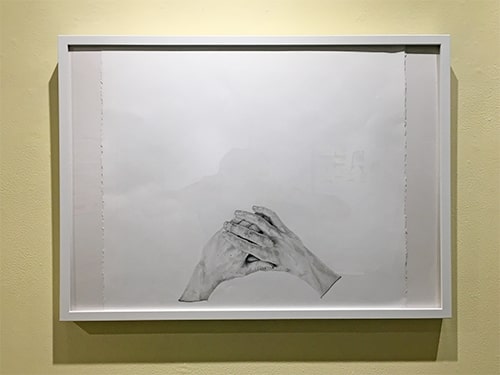
For Russell Drawing, NFS
Bio:
Natalie Lauchlan is a daughter. She is an emerging artist and educator living as a settler in Canada, on Treaty 7 land.
She collects fragments of text that come to arrange themselves in her memory. She reads the tenderness of objects and transcribes the poetics of space.
Exploring the ephemeral, she is the ghost haunting all her memories.
www.natalielauchlan.ca
Wes Bell
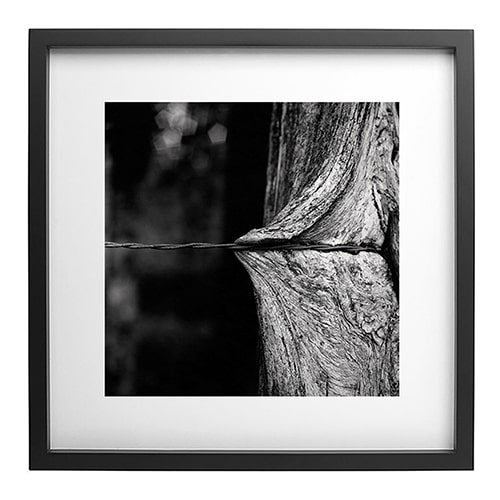
Rapt – Towpath Road, Accord, NY, USA (2013) Gelatin silver prints, $650
This series of photographs focuses on trees that have been used as supports for a variety of chains, cables, or sections of fencing, used to restrict access to the landowner’s property. Over time, as these trees continue to grow with these constricting bands of material, the dialectical tension between man and nature builds to a particularly emotional pitch. As the wires, cables and chains cut into the trunk of the trees (a process literally called ‘stangulation’), the organic vegetal response seems to embody human, visceral feelings of pain, emotional constriction and dogged survival. Rapt. The series of fifty-five photographs made in 2013 thru 2017, opens the landscape into a series of tightly focused moments of intense engagement between man and the natural environment. The sites I photographed spoke to me strongest in the days of transition from winter to spring when the scene was enveloped in flat, gray light and there was no foliage on the trees to distract from them. Wes Bell
Maren Kathleen Elliott
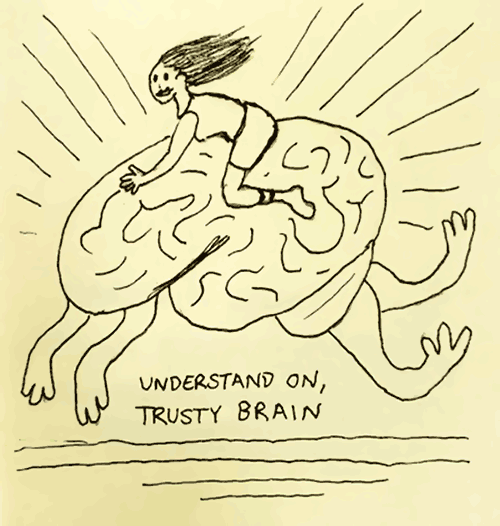
Sticki Series – understand on, trusty brain (2019): Ink on sticky notes and paper, NFS
As someone who suffers from mental illness, I am no stranger to vulnerability, and this is a theme that arises in my work. Specifically, I am interested in exploring how vulnerability in storytelling strengthens human connection. As an artist, the most important thing I can do is follow a process of observation and reflection. I find that the little things I observe in my everyday life provide the most meaning in my work. I see light and shadow, faces, stories, human relationships and the connection between self and place. I try to then understand my feelings about these observations and express these emotions through my creative work.
I often work with three-dimensional objects on a two-dimensional plane, sourcing materials that are cheap, found, made en masse and easily accessible. In my studio items such as glass vials, toilet paper rolls, yarn and other craft supplies mix with conventional art mediums such as acrylic paint and markers. By working in nontraditional and mixed media I hope to deconstruct the elitism that often creates a barrier between the contrived categories of “artist” and “non- artist”.
Human connection is also paramount in my work. I interview my subjects and include others in my process, whether it be in the various stages of creation, or through interactive elements in the finished work.
Father Douglas, osf
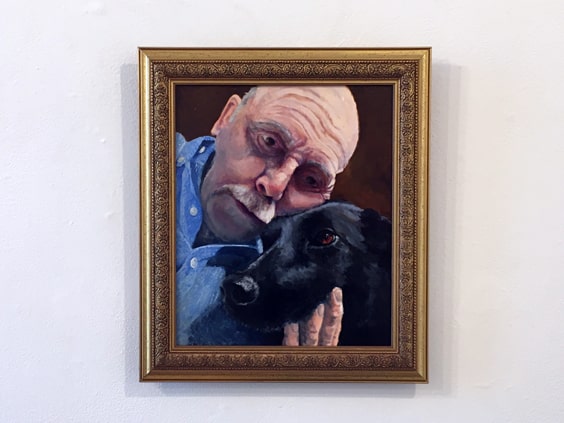
Self Portrait with Bronson, oil on panel, $500
Artist’s Statement
I find painting a spiritual experience, very much like prayer or meditation, a time to retreat within oneself and leave behind the peripheral world.
I paint in silence and find that this allows me to fully concentrate on the process of creating my art and not to be distracted by irrelevant diversions. It allows me to work on a painting by knowing intuitively what works or how to make something work by instantly recalling how to solve a problem. Silence helps to leave me free to introduce an idea that may come to me quietly while I am creating and allows me to contemplate on how this idea is relevant to the work in progress. Silence is golden.
I achieve great joy in painting subjects that strongly appeal to me for their beauty since I have been taught that an artist must truly love their subject matter in order to produce a superb painting. This practical advice has become the cornerstone on which I form my vocation as an artist. I also demand a test, one to paint objects that are difficult to achieve a realistic look, such as glass, crystal or silver and am constantly seeking more challenges. Because I have a great fondness for dogs and enjoy painting them I have named (my) web-site Doggone-art.
Artwork can be purchased by using PayPal and if you have any questions you can reach me at doggone-art@live.com
Riisa Gunderson

Artist Statement 2020
My painting practice examines the performance of femininity in the context of private spaces and activities, particularly as it relates to my experiences of intrusive thoughts, anxiety and depression. Through self-portraiture and still life I document situations of mental turmoil within the intimate home environment, which takes on a sinister role, full of rotting food and cluttered refuse. The figure is invaded by areas of clumpy, overworked wax and paint, referencing the compulsive picking and scratching habits I experience in connection with anxiety attacks.
The abject plays a central role in these tableaux, and I’m interested in the bodily reactions such moments provoke in the viewer; the tightening of the gorge, a sudden jarring in the gut. These types of feelings relate to my own physical experiences of mental phenomena, drawing the viewer deeper into my personal narrative; when the viewer looks at my body, the nude, they are made to feel their own bodies. The abject then acts as both a metaphor for the sensations I’m attempting to relay, and a means of disrupting objectification of the figure. Through this series of tense encounters, the serene pleasure in looking at the nude is repeatedly denied.
Christian Peres Gibaut
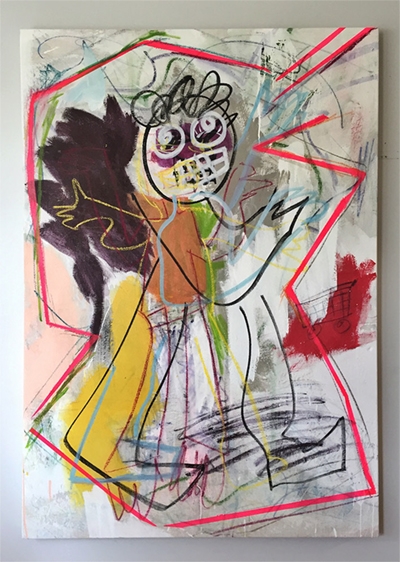
Si naciste pa’ martillo del cielo te caen los clavos Acrylic, coloured pencil, charcoal, graphite, ink, soft pastel, spray paint on canvas, $1800
Born in Buenos Aires, Argentina, Christian Pérès Gibaut uses a variety of mediums to explore the notions of identity and memory, both as an individual and as societal constructions. His body of work includes paintings, drawings, murals, mosaics, public art, and collaborative projects. His practice consists of obsessively worked images on the antithetical and absurd relationship between change and permanence, order and entropy, will and conditioning. Pérès Gibaut’s playful, unaffected approach to form, mark making, and materials, balances the gravity of these difficult questions, resulting in nuanced compositions that manifest the complexity of the human condition. He has worked and exhibited in Argentina, Brazil, Chile, Colombia, France, Mexico, Uruguay, and the US. He lives and works in Edmonton, AB. christianperesgibaut.com


